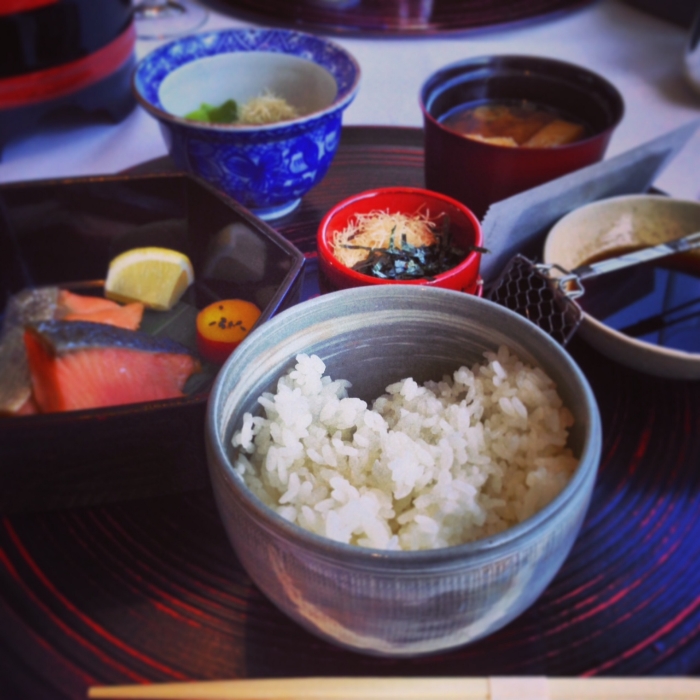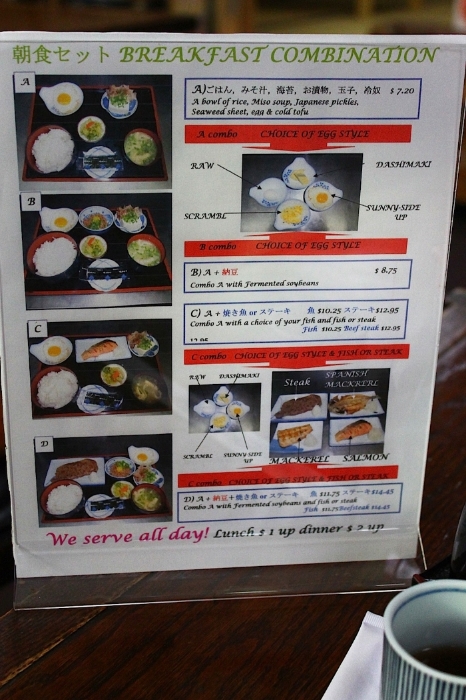Inside a Japanese supermarket in an unremarkable stretch of West LA there is a very special, wonderful place. I go there when I feel a cold coming on, have had a taxing day, or just need something wholesome and soothing and delicious, and it invites me into its world of delights. It is a food court, florescent lighting illuminating such décor elements as a community bulletin board, an early 90s-era TV bolted to a corner of the ceiling, and glossy faux wood tables. I generally find it has a cure for whatever ails me.
A visit to Mitsuwa begins with a selection—will it be udon or soba from Sanuki? Tempura from Hannosuke? Or ramen from Santouka? You will order, pay in cash, receive a stub with a number, and search for an open table. You will wait, listening to a steady roll call of orders from the different restaurants being called over a loudspeaker. Your number is finally called—your time has come! You rush over to retrieve your cafeteria tray with steaming bowl of one or another Japanese comfort food.
Before my first visit to Santouka, I was under the impression that ramen broth was much like pho broth—clear and smooth, a thin but flavorful vehicle for the slurping of noodles. As it turns out, I was mistaken. This Hokkaido style ramen broth is murky and gritty, and unbelievably rich and fatty and flavorful. I could hardly believe my taste buds when I first sipped the salt ramen broth. This broth is no mere vehicle; it’s the epitome of comfort food, it warms your body and coats your mouth with its rich, deep pork flavor. After a long day of teaching, it’s the first thing I crave.
Santouka offers a variety of options—spicy miso broth, soy broth, and salt broth, small/medium/large bowls, and combination dinners that include pork on rice, fermented soybeans on rice, or salmon roe on rice and all come with a soy sauce tinted hard-boiled egg. I’ve had them all, and I am compelled to steer you towards the salt ramen. While the others are delicious, the salt ramen is unlike anything else I’ve ever tasted. It comes topped with two precious slices of the tenderest, meatiest pork you could hope for, a pink-swirled fish cake, some delightfully rubbery dark brown mushroom pieces, a few root vegetable slices and a pile of chopped scallion. The noodles are spindly and springy and chewy with a bit of a bite to them, the perfect noodle texture.

You also have the option to spring for the “special pork,” a few extra pieces of even fattier, meltier meat, if you can imagine that, but rather than spending extra for the pork, I would recommend spending an extra few bucks for a combo with the salmon roe on rice. Even if you can only manage a few bites of the salmon roe after downing a most perfect bowl of ramen, it’s worth it. The plump orange pearls of salmon egg are bursting with briny flavor. It’s a treat that’s worth at least trying. Even with the salmon roe rice and the egg, a small ramen combo is only $11.50. One word to the wise: if your palate is like mine, somewhat unaccustomed to what the Japanese may consider mundane, the fermented soybean on rice (natto) is one of the worst things you’ve ever tasted. Perhaps you’re not like me, and you enjoy the taste of slimy rotting soy sauce. Still, I feel obligated to give you fair warning on such things.
Next to Santouka you will find one of my favorite spots for udon and soba. Sanuki is probably the cheapest of the Mitsuwa restaurants—as in I always get change for $10 and leave stuffed—which is only a minor part of why I find myself there so frequently, eagerly dipping in to a huge, steaming bowl of delicious fish broth.

It is a matter of personal preference, but despite my unequivocal love of Japanese food in its many varieties, I often find Japanese broths to be too fishy tasting for me. I’ve never been a devotee of miso soup, for example. So even though I do certainly worship at the temple of udon and soba noodles, the one stick in my craw is that amongst the extremely complex layers of flavors in Asian broths, I sometimes encounter one that strikes a slightly unfavorable note. The point I am getting at here is that the flavors of the broth at Sanuki are beautifully harmonious, without a hint of dissonance—the broth is translucent and the flavor is deep and complex, a little bit sweet, and not very fishy. It is fish based, but it doesn’t taste quite so much of kombu as the more upscale udon broths I’ve tasted. Just saying. A big bowl of Sanuki’s broth with their chewy, squiggly udon noodles is heaven on earth if you feel a little under the weather. I usually go for the chicken or fried bean curd on my soup. Do yourself a favor and whatever you order, get a side of the fried bean curd, (warm please). Even if you’ve ordered the bean curd udon, you will want more. I always do. It’s so sweet and fluffy and has that uniquely spongy inari texture.
This brings me to the tempura portion of the evening. In general, I’ll be honest, I try to not to make my dinner entirely out of deep fried things. It doesn’t seem prudent, longevity-wise. But the tempura at Hannosuke is so unique as to be a must-try and will definitely have you hooked. The most intriguing feature of this Tokyo transplant’s fare is that the tempura sauce is fried into the batter, miraculously. No dipping required. It’s like those Eggo waffles with maple syrup crystals inside the waffles. Well, it’s nothing like that, because this doesn’t come out of your toaster somehow simultaneously dry and soggy. But it’s the same idea.

The tempura battered shishito peppers, white fish, squid, shrimp, prawn, sweet potato, seaweed and poached egg (yes, a tempura-fried poached egg to crack over your rice bowl), come out crisp and crunchy and sweet. They’re all served over a large bowl of white rice, which contains a delicious surprise—thick, sweet sauce hiding below the surface.
These three gems comprise my happy place, my go-to when nothing else feels right for dinner. There is a fourth restaurant in the food court, and it’s perfectly fine. They serve bento boxes with standbys like katsu and teriyaki. It’s not bad at all, it’s just that the other three places are perfect. I ritualistically end my meals at Mitsuwa by browsing the endless wonders in the candy aisle of the supermarket. From gooey aloe flavored gummies to shrimp chips to green tea flavored Kit-Kats, I can’t even begin to list the vast array of unfamiliar sweets in that grocery store. There are probably thirty completely different things just shaped like pandas. Here’s to someday exhausting all the possibilities that aisle has to offer.

I have never been to Japan—I plan to go this fall and I can’t wait—but for now, this place feels pretty close.














